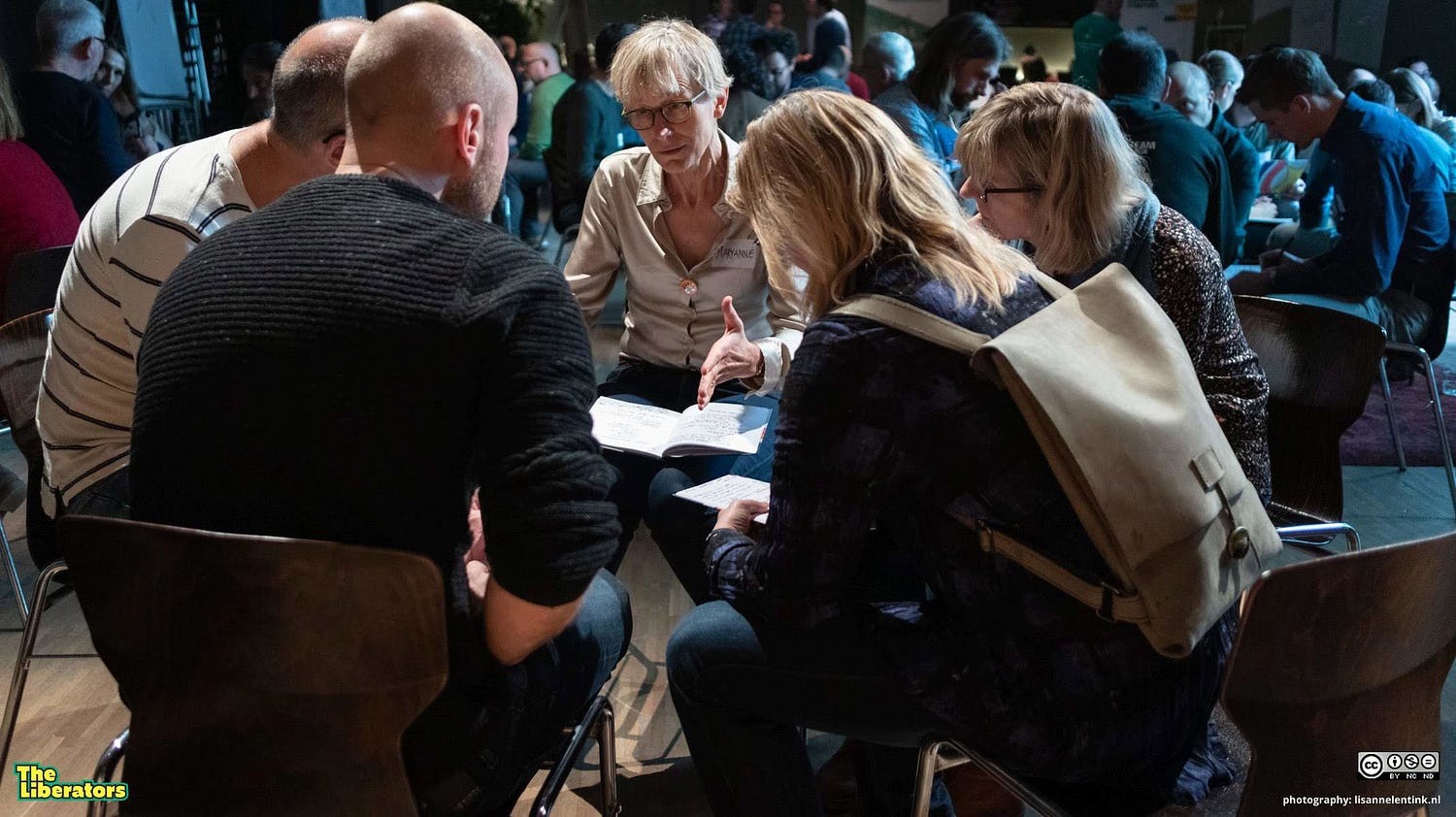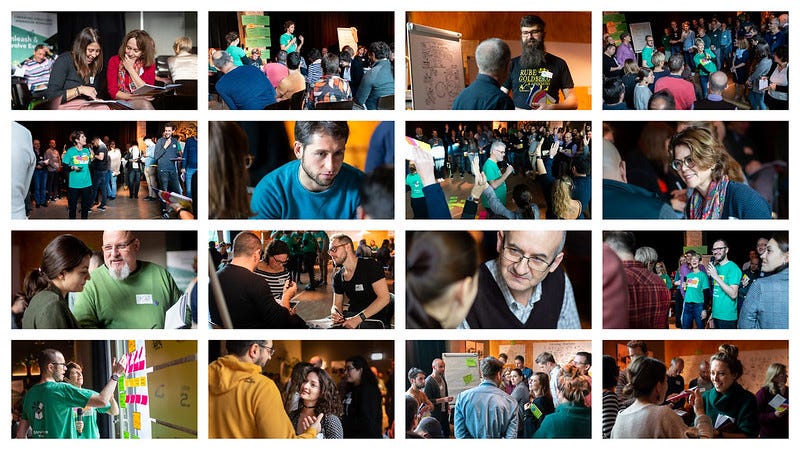Self-organizing teams are all the rage. Organizations aim to become Teal or shift traditional structures to entirely self-steering teams. When done for the right reasons, these shifts are something I encourage. It seems like a good way to appreciate the autonomy and intelligence that we all have.
But one pattern I’ve observed is that this shift is often so abrupt that it leaves teams gasping for air with a degree of autonomy they aren’t used to. And in this state of disorganization, socially detrimental things happen as louder voices start dominating the more silent ones, power struggles emerge and groupthink happens.
Herein lies the Wicked Question that is at the heart of Liberating Structures; how can you liberate individual perspectives, views, and opinions while also structuring how groups interact at the same time? In this post, I explore this question from the perspective of self-organization.
“Self-organization is the process by which spontaneous order arises from something that is initially disorganized.”
What is self-organization?
Self-organization is the process by which spontaneous order arises from something that is initially disorganized. This order is spontaneous, and the result of self-organization, only when it emerges from the interactions of the smallest units of the system and isn’t imposed by outside influences. Self-organization happens all around us and on many different levels. It happens when birds flock into swarms that dance and wave across the sky. It happens when ants work together to build massive colonies, without a clear intelligence guiding it. And it happens when people effortlessly avoid walking into each other when large crowds intersect. In this post, we’ll focus on self-organization as it happens in groups and organizations.

Liberating Structures promote self-organization by giving a voice to everyone, slowing down as needed, but without losing pace. Picture by Lisanne Lentink
One example of self-organization
When you take a group of fifty workers, they will initially be disorganized as they don’t know what to do or how to work together. A manager can create order by giving workers instructions or provide them with blueprints for the tasks to perform. But since this order is imposed, it isn’t self-organization. Alternatively, the workers can come to a shared understanding and work together without external instructions. The key difference here is in the degree of autonomy that workers have to create the rules by which that work is done (the ‘order’). Or, alternatively put, how isolated workers are from outside influences that try to impose order on them.
Self-organization is a continuum rather than a binary thing. As outside influences decrease, the ability of a group to self-organize increases. So despite popular belief, self-organization doesn’t mean ‘no rules at all’. In fact, self-organization is all about creating those rules. But instead of having them imposed, groups discover (or decide to use) them on their own. And this is where Liberating Structures come in.
“When I think about the repertoire of 33 Liberating Structures [ … ], I think of them mostly as simple rules to encourage self-organization”
Liberating Structures
When I think about the repertoire of 33 Liberating Structures, curated by HENRI LIPMANOWICZ and Keith McCandless, I think of them mostly as simple rules to encourage self-organization.

Simple rules that allow people to be fully engaged with each other
Each structure is one way for groups to create order in what they are doing. For example, Min Specs is helpful to create rules or work agreements. A 1–2–4-ALL quickly gathers ideas, perspectives, and options from everyone in the group. An Ecocycle Planning helps groups focus on what is important to them, and creatively destroy the rest. By combining different structures into strings, where each flows naturally into the next, groups can explore challenges, conflicts, and opportunities together. For example:
- At the start of a new team, start with Nine Whys to help clarify the purpose of their work together. Then proceed with Min Specs to create work agreements on how to achieve that purpose. Use Ecocycle Planning to plot a group’s current activities and use 1–2–4-ALL to identify what to let go.
- Develop strategies together by first identifying the challenges that teams face with Wicked Questions. Pick the one that is the most critical and uncertain, and plot it as the axes for Critical Uncertainties. Develop strategies to remain effective in four potential scenarios and use 15% Solutions to translate the most robust ones into the first steps.
- Make sense of shared failure by starting with a Conversation Cafe. Then do a TRIZ to see what you can do to make it worse. Follow-up with ‘What I Need From You’ to make clear requests for help (and accept or reject them).
“The gist of Liberating Structures is that — once you speak the language — you can start reframing every interaction from their perspective”
A casual glance at the steps of the structures might lead to the conclusion that it isn’t all that different from other techniques, like Gamestorming and LEGO Serious Play. And although these are very useful in their own right, there is significantly more depth in how Liberating Structures foster self-organization all the time.
The gist of Liberating Structures is that — once you understand its language — you can reframe every interaction from their perspective. Not for the sake of using Liberating Structures, but for the sake of continuously creating an environment where every voice is heard, seen and respected. Where I initially also understood them as a tool for some situations, I soon discovered that their richness and flexibility allows me to use them in any situation. This was a seismic shift in my understanding of our work with groups and led us to rethink all our group-based interactions in terms of Liberating Structures. Not in a dogmatic way, but in a way where we riff and configure the micro-organizing elements of the structures to find the best way to build on the principles of Liberating Structures:
- Include and Unleash Everyone
- Practice Deep Respect for People and Local Solutions
- Build Trust As You Go
- Learn by Failing Forward
- Practice Self-Discovery Within a Group
- Amplify Freedom AND Responsibility
- Emphasize Possibilities: Believe Before You See
- Invite Creative Destruction To Enable Innovation
- Engage In Seriously-Playful Curiosity
- Never Start Without a Clear Purpose(s)
“You had to be there …”
Only reading a post like this won’t tell you what the experience of a solid string of Liberating Structures is like. So if you have the option — and especially if you’re skeptical — try to visit an Immersion Workshop near you. The best Immersion Workshops are hosted by practitioners from local LS User Groups and people that are active in the global community. These intense, 2-day experiences give you a very visceral experience of just how Liberating Structures encourage self-organization. As one participant recently put: “I discovered that Liberating Structures are more of a social movement than a method”.
“I discovered that Liberating Structures are more of a social movement than a methodology”
Skills for users, not facilitators
The perspective of self-organization also helps us better understand why the frame of “Liberating Structures as tools for facilitators” is incomplete. When they are only used when an external facilitator is brought in, the ability of a group to self-organize never truly materializes. Although a lot of valuable ideas may emerge by having an external facilitator, the rules of Liberating Structures themselves are still imposed. Hopefully as gently and subtly as possible, but imposed nonetheless.
Five tips to make this happen
So what can you do to use Liberating Structures in a way that encourages self-organization? We’ve found the following helpful:
- Even when you’re an external facilitator, always facilitate together with people from the group you’re working with. Work with them to create a string and distribute facilitation. Help them become better by giving them feedback, both positive and constructive.
- Use Design Storyboards to quickly design a string together at the start of a gathering. When people have little experience, you can help them think about the purpose of the gathering, the steps to take and which structures would fit.
- When groups meet, ask “How can we best structure this interaction to allow everyone to fully engaged and involved? Which Liberating Structures make sense?”. Or simply start with a 1–2–4-ALL based on a core topic and then decide what next steps make sense.
- Instead of starting by explaining the steps of each structure, begin by explaining the purpose and how it connects to what happened before. This makes the experiences much smoother and more natural.
- Set the expectation that learning how to use the language of Liberating Structures is learning how to play music. It takes practice. You may hit some wrong notes. People will feel a bit uncomfortable (or scared) to try. But as you become more fluent — and the simplicity of LS really helps here — it becomes second-nature.
Closing words
In a very real sense, Liberating Structures are instruments for self-organization to take place in groups and across organizations. If you haven’t already done so, I encourage you to give them a try. And if you have, and you recognized something in this post, please let me know in the comments.
Interested in learning many different Liberating Structures in an intense 2-day workshop? Check out our agenda for upcoming Immersion Workshops. If you’re aiming to join, book early — they are exceptionally popular. And join the Dutch User Group to learn more about Liberating Structures. Check our other writing on Medium. If you like our free content, meetups, podcasts and tools, please consider supporting us. Click here for ways to do so.

